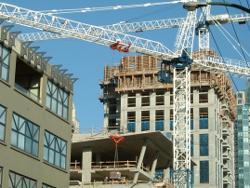Kermit Baker Predicts Growth in Both Com. & Res. Remodel Sectors
Chattanooga, TN, July 21, 2017-Despite previous predictions of a downward turn, the most recent Architecture Billings Index is looking up. Over the past five months, the index has been over 50, and June’s report shows a reading of 54.2, while inquiries are decreasing.
“We seem to be building some momentum in terms of design activity,” said Kermit Baker, Harvard economist. “Inquiries are a softer measure; I like to focus on new project activity coming in to architecture firms, and those numbers have been extremely strong recently.”
When looking deeper at the report, each region is performing well, but the strongest are the west and south. In terms of increased job creation, the larger firms are hiring more than their smaller counterparts.
“That has something to do with the sectors they’re in. The rule of thumb I use is very crude, but it does have some validity: small firms tend to focus their practice on residential projects, mid-sized firms on commercial and industrial projects and large firms on institutional projects,” said Baker. “The turn up in terms of large firm activity is really in some sense reflecting the strength that we’re seeing for larger institutional projects.”
In terms of vertical sectors, previous reports featured a strong showing from hospitality, and the healthcare and education, while soft, were making a turn. Baker says that is still the case. The uncertainty with the federal healthcare issue discourages investment, which will require stabilization before strong improvements. For education, the second big component in the institutional sector, Baker cites state and local government fiscal improvements, increased housing prices and thereby more property tax revenue for local governments to build new facilities as reasons for the sector’s improvement.
“I don’t report this a lot, but we do every quarter track backlogs of architecture firms, how much work they have in house,” said Baker. “The past two quarters we’ve seen the strongest number in backlogs since the last recession. It does point to a good second half of the year for design activity, and a reasonably solid 2018 for construction activity.”
Baker’s position as a senior research fellow at the Joint Center for Housing Studies gives him insight into future trends in home improvement activity. His findings show this sector growing at approximately 7% per year, which is above average for the past few decades. He attributes this to homeowner confidence and good interest rates. However, home ownership is at a low point.
“Home ownership level is the lowest it has been for the past 50 years. That’s a concern, and it may have to do with the rate at which younger households are getting into the owner market,” said Baker. “Millennials have delayed the age they’re getting married, the age they’re having children, and therefore delayed the age that they’re buying their first home. That traditionally has been in the late 20s or early 30s, and it has been ticking up into the mid-30s, even later 30s.”
With all the changes coming from ecommerce and telecommuting, Baker sees labor as the biggest challenge facing the market. He attributes the uncertainty of immigration policy as a contributing factor with this issue, because almost 30% of the construction labor comes from immigrants, in just one of the many ways the changing economy affects the built environment.
